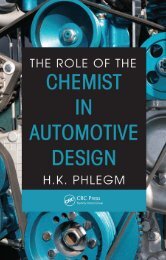Lightweight Electric/Hybrid Vehicle Design
Lightweight Electric/Hybrid Vehicle Design
Lightweight Electric/Hybrid Vehicle Design
You also want an ePaper? Increase the reach of your titles
YUMPU automatically turns print PDFs into web optimized ePapers that Google loves.
Introduction xvii<br />
With the high volume builders, already under pressure from overcapacity, their main attention is<br />
likely to be focused on retaining markets for current design vehicles, without the ‘distraction’ of<br />
radical redesigns. The ambitious, imaginative and high technology specialist has thus much to<br />
gain from an informed innovative approach and could benefit from a reported longer-term trend<br />
when drive systems will be manufactured by huge global producers and vehicle manufacturing<br />
will tend towards a regional basis of skilled body shops catering for local markets.<br />
0.2.5 EV AS PART OF A WIDER TRANSPORTATION SYSTEM<br />
The ‘physical’ design package for an electric vehicle will result from a much larger ‘design package<br />
of affecting factors’ which encompasses vehicle operational category, manufacturing systems/<br />
techniques, marketing and distribution. Packages for industrial trucks and specialist delivery vehicles<br />
are already established but those for passenger-car variants much less so. It has been suggested<br />
that the first substantial sales of electric cars might well be to electricity generating companies in<br />
the public utilities sector, who would rent them to railway operators for end-use by rail travellers.<br />
Such people would purchase their hire with return travel tickets to destination stations at which<br />
EVs would be parked in forecourts for the use of travellers. Other potential customers might be<br />
city-centre car hire fleets, taxicab operators in fossil-fuel exhaust-free zones or local authorities<br />
setting up city-centre car pools.<br />
One of the most imaginative EV applications is the lightweight mini-tram, Fig. 0.2, as exhibited<br />
at the Birmingham ElectriCity event in 1993. This is a vehicle that runs on low cost tracks which<br />
can be laid on an ordinary road surface without further foundation. The vehicle can travel up to 50<br />
km/h and is a flywheel-assist hybrid machine having its batteries recharged via low voltage<br />
conductor rails positioned at intervals around the track. Each car weighs just over 3 tonnes unladen<br />
and can carry 14 seated and 11 standing passengers. A 5 km route, including rails, can be constructed,<br />
to include five trams, ten stops and four charge points, at a cost of just £1 million. It seems an ideal<br />
solution to the problem of congested cities that have roadways that date back to pre-automobile<br />
days, with the mini-trams able to transport both passengers and goods in potential ‘pedestrian<br />
precincts’ that would be spoilt by the operation of conventional omnibuses and tramcars. The<br />
proposal serves well to illustrate the opportunities for electric vehicles, given some imaginative<br />
lateral thinking.<br />
Since launch, larger vehicles have been produced and entered service. The one seen at Bristol<br />
Docks (Fig. 0.2, right) has a steel frame with GRP body panels and weighs 13 tonnes, compared<br />
with the smallest railcar which weighs 48 tonnes. There are four production variants on offer,<br />
carrying 30, 35 or 50 passengers, and a twin-car variant of the latter. Use of continuously variable<br />
transmission now ensures the flywheels run at constant speed; a third rail at stations is used for<br />
taking in electricity for ‘charging up’ the flywheel. A 2-minute recharge would be required for the<br />
Fig. 0.2 Parry flywheel-electric hybrid rail bus.







